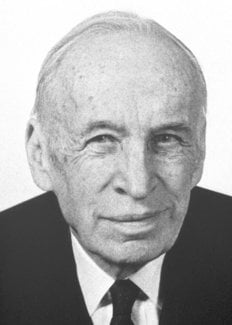John H. Van Vleck
Biographical

I was born in Middletown, Connecticut, March 13, 1899 where my father and grandfather were respectively professors of mathematics and of astronomy at Wesleyan University. However, when I was seven years old father accepted a professorship at the University of Wisconsin, so I grew up in Madison, Wisconsin, where I attended the public schools, and graduated from the University of Wisconsin in 1920. As a sort of revolt against having two generations of academic forbears, I vowed as a child that I would not be a college professor, but after a semester of graduate work at Harvard, I outgrew my childish prejudices, and realized that the life work for which I was best qualified was that of a physicist, not of the experimental variety, but in an academic environment.
I have been lucky in a number of respects. Coming from an academic family, I had invaluable parental guidance or advice at various times. At Harvard I took most of my courses under Professor Bridgman or Professor Kemble. The latter’s course on quantum theory fascinated me, so I decided to write my doctor’s thesis under Kemble’s supervision. He was the one person in America at that time qualified to direct purely theoretical research in quantum atomic physics. My doctor’s thesis was the calculation of the binding energy of a certain model of the helium atom, which Kemble and Niels Bohr suggested independently and practically simultaneously, with Kramers making the corresponding calculation in Copenhagen. The results did not agree with experiment for the “old quantum theory” was not the real thing. However, when the true quantum mechanics was discovered by Heisenberg and others in 1926, my background in the old quantum theory and its correspondence principle was a great help in learning the new mechanics, particularly the matrix form which is especially useful in the theory of magnetism.
I was fortunate in being offered an assistant professorship at the University of Minnesota in 1923, a year after my Ph. D. at Harvard, with purely graduate courses to teach. This was an unusual move by that institution, as at that time, posts with this type of teaching were generally reserved for older men, and recent Ph. D.’s were traditionally handicapped by heavy loads of undergraduate teaching which left little time to think about research. Also it was at Minnesota that I met Abigail Pearson, a student there, whom I married June 10, 1927, and on Nobel Day, December 10, 1977 we had been married exactly 50 1/2 years!
I was also lucky in choosing the theory of magnetism as my principal research interest, as this is a field which has continued to be of interest over the years, with new ramfications continuing to make their appearance (magnetic resonance, relaxation, microwave devices, etc.). So often a particular field loses general interest after a span of time. My last paper dealing with magnetism was published fifty years after my first one.
Besides my work on magnetism, and the closely related subjects of ligand fields and of dielectrics, one of my interests has been molecular spectra. The theoretical problems associated with the fine structures therein appeared rather academic at the time, but recently have burgeoned in interest in connection with radioastronomical investigations, including notably those of the observatory at Gothenburg.
| Degrees, positions, awards, etc. |
| A.B. University of Wisconsin, 1920 |
| Ph. D., Harvard University, 1922 (instructor 1922-3) |
| Honorary D. Sc. or D. Honoris Causa, Wesleyan U., 1936; U. Wisconsin, 1947; Grenoble U., 1950; U. Maryland, 1955; Oxford U., 1958; U. Paris, 1960; Rockford College, 1961; U. Nancy, 1961; Harvard U., 1966; U. Chicago, 1968; U. Minnesota 1971. |
| On faculty, University of Minnesota, 1923-28; University of Wisconsin 1928-34 Harvard University 1934-69, emeritus 1969 – (Dean of Engineering and Applied Physics 1951- 57). |
| Lorentz (visiting) professor, Leiden, 1960; Eastman Professor, Oxford, 1961-62; Guggenheim Fellow, 1930. |
| Foreign member, Royal Swedish Academy, Uppsala Academy, Netherlands Academy, Academie des Sciences, Royal Society of London. |
| National Medal of Science, USA; Lorentz Medal (Netherlands); Cresson Medal (Franklin Institute); Michelson Prize of Case Institute of Technology; Langmuir Award in Chemical Physics; General Electric Foundation; Chevalier, Legion of Honor. |
| Member, National Academy of Sciences, American Academy of Arts and Sciences, American Philosophical Society, International Academy of Quantum Molecular Science; Honorary Member, French Physical Society; President, American Physical Society, 1952. |
This autobiography/biography was written at the time of the award and first published in the book series Les Prix Nobel. It was later edited and republished in Nobel Lectures. To cite this document, always state the source as shown above.
John H. Van Vleck died on October 27, 1980.
Nobel Prizes and laureates
Six prizes were awarded for achievements that have conferred the greatest benefit to humankind. The 14 laureates' work and discoveries range from quantum tunnelling to promoting democratic rights.
See them all presented here.
